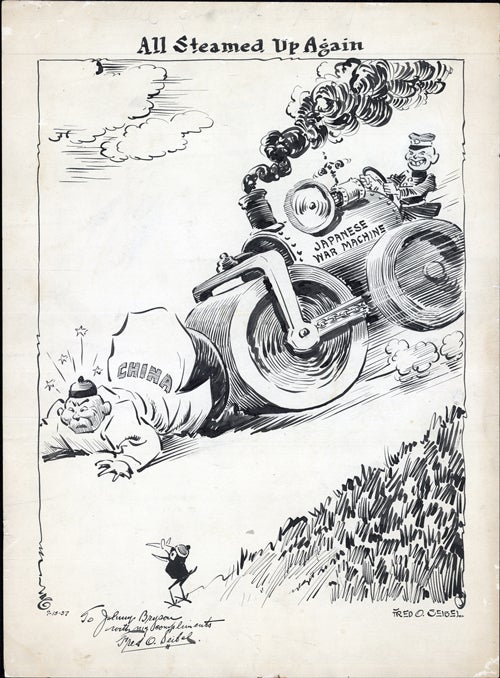 “All Steamed Up Again” (07/13/1937)
“All Steamed Up Again” (07/13/1937)
By Fred Otto Seibel (1886 – 1968)
12 x 16 in., ink on paper
Coppola Collection
Frederick Otto Seibel was a prolific editorial artist. With a career spanning 60 years, he produced an estimated 16,000 cartoons.
Trouble plagued China and Japan for a hundred years. In 1931, things sparked up again when Japan invaded Manchuria, in part to relieve burdens back home caused by the Great Depression.
From 1931-1937, China and Japan continued to skirmish, and Japan was winning ground, capturing both Shanghai and the capital, Nanjing, in 1937.
By July 1937, the Imperial Japanese Army had already surrounded Beijing and Tianjin, with thousands of troops stationed along the railways, including one of the main entry points between Beijing and Tianjin, the old walled city of Wanping (located about 9 miles SW of the Beijing city center).
On July 7, 1937, the Japanese were conducting military exercises outside of Wanping. As the story goes, a Japanese soldier failed to return to his post, and the Chinese received a message demanding that the Japanese enter Wanping to look for him. The Chinese refused, and both sides began to mobilize.
Although the soldier actually returned to his unit, by the late evening of July 7 gunfire was exchanged and the Japanese attempted to breach the defenses at Wanping.
The attacks took place at an ancient stone bridge (the Marco Polo Bridge) in the Wanping district, which provided access to the rail station. The 7/7/37 date is considered to be the start of the second Sino-Japanese War, which lasted until 1945.
The tensions did not go down, and the next day, as troops were massing, shots were fired and the Battle of Beijing-Tianjin marks the first major conflict recorded in the 8-year war. The Chinese were outflanked and the Japanese had scored many victories. Between July 11 and 20, hundreds of thousands of Japanese troops were occupying the Beijing-Tianjin area.
This Seibel cartoon, from July 13, 1937, is clearly consistent with a message coming out of Asia that the Japanese were once again steamrolling over the Chinese.
Although the German invasion of Poland in September 1939 generally designates the starting date of WWII, there are those who see this war of Japanese aggression and the 7/7/37 date as an equally legitimate marker, given the alliance that would eventually emerge.

